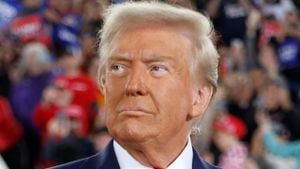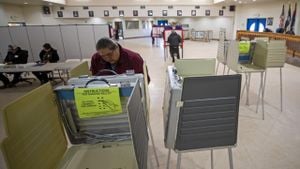The U.S. stock market experienced significant gains on Election Day as voters flocked to the polls, creating an eager atmosphere among investors awaiting the results of what many are describing as one of the most hotly contested presidential elections of recent years. Major indexes like the S&P 500, Dow Jones Industrial Average, and Nasdaq Composite all reported solid upward movements, reflecting traders' optimism at the polls. This broad-based rally was stoked by stronger-than-expected economic reports and anticipation surrounding potential Federal Reserve interest rate cuts.
Leading the charge, the S&P 500 saw gains of about 1.2%, with the Dow Jones adding more than 400 points, marking a rise of approximately 1%. The Nasdaq Composite, often seen as the index most sensitive to tech stocks, surged by 1.4%. A notable contributor to this surge was the performance of major tech companies, with shares of Nvidia, the AI chipmaker, climbing nearly 3% at the opening. By the end of the day, tech giants such as Meta and Amazon had their shares up around 2%.
Interestingly, trading on Election Day isn't just influenced by the election itself. Analysts pointed to the larger backdrop of positive economic data released just before the election as contributing significantly to the market upswing. For one, reports showed solid economic growth, which brought renewed optimism about the U.S. economy moving forward. The latest government statistics indicated strong performance over the previous three months along with signs of easing inflation, painting a healthier economic picture than what some had feared.
Despite the positive momentum, there was turbulence within certain stocks. For example, the Nasdaq had to temporarily halt trading of Trump Media and Technology Group Corp., the media company of former President Donald Trump, after shares dropped sharply15 minutes before the afternoon close. This dramatic dip saw the stock price falling from $37 to $34 before settling at close to $33.94.
Market analysts surfacing these morning gains pointed out the emotional weight of the day—due chiefly to the long campaign leading up to the election. Ivan Feinseth, the market analyst at Tigress Financial, expressed relief, stating, "The nightmare of an endless election and contentious battle has consumed much focus and attention. It’s almost over. Then it returns to the fundamentals of the market."
Interestingly, the gains witnessed on Election Day not only added to the stock market's impressive performance this year but also marked significant progress for major indexes overall. Since the start of 2024, both the S&P 500 and Nasdaq have soared by more than 20%, with the Dow Jones up by about 11%. Much of this success can be attributed to continued excitement about the artificial intelligence sector and expectations for declining interest rates.
The Federal Reserve’s latest benchmark interest rate cut from September, where it was reduced by half a percentage point, also played its part. This reduced rate eases pressure on corporate borrowing, paving the way for potentially higher profits for companies. There is anticipation building around the Fed's upcoming meeting on Thursday when analysts expect another quarter-point interest rate cut, as evaluated by the CME FedWatch Tool.
Sustained investor optimism often correlates with expectations surrounding interest rates. Generally, when rates fall, it creates conditions favorable for driving stock prices up, which is precisely what analysts expect moving forward. Opinions diverge concerning the ultimate impact of differing presidential policies on the market, with experts noting the importance of focusing more on market fundamentals rather than political climates.
Notably, one considerable risk highlighted by experts is the expectation of continued increases to public debt, regardless of who holds the presidential position post-election. Such scenarios could meaningfully impact market dynamics long-term, driving investors to balance their strategies based on both candidate policies and overarching economic indicators.
All said, Election Day did not just bring about excitement at the polls but also served as a catalyst for market movements. The anticipation of what the outcomes would mean, combined with positive economic indicators and the Fed's policy adjustments, positioned the stock market to perform viably amid the uncertainty of election outcomes.



